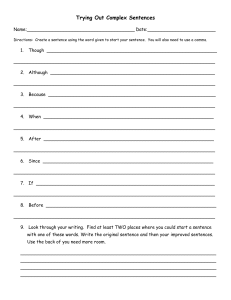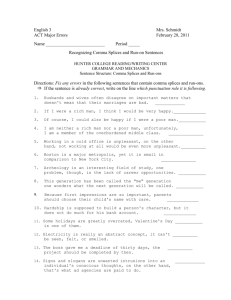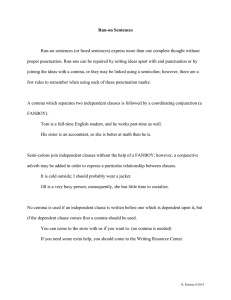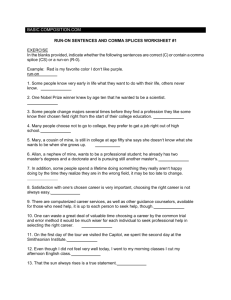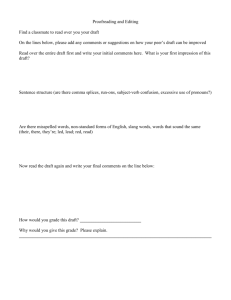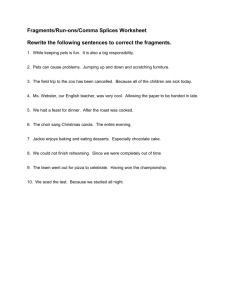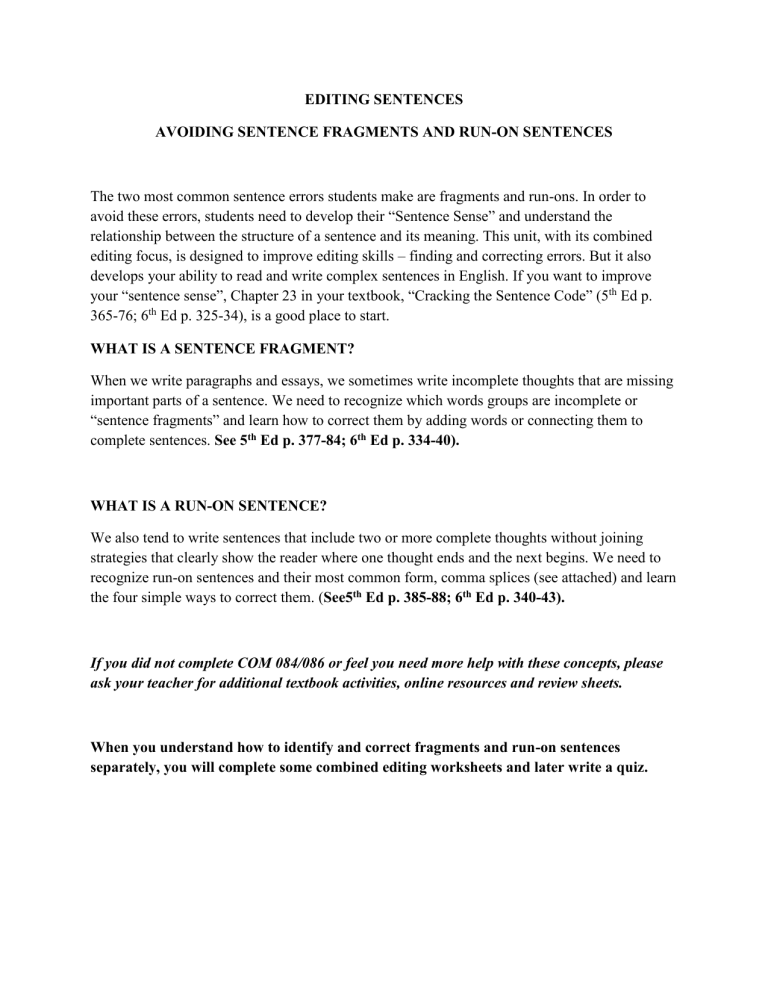
EDITING SENTENCES AVOIDING SENTENCE FRAGMENTS AND RUN-ON SENTENCES The two most common sentence errors students make are fragments and run-ons. In order to avoid these errors, students need to develop their “Sentence Sense” and understand the relationship between the structure of a sentence and its meaning. This unit, with its combined editing focus, is designed to improve editing skills – finding and correcting errors. But it also develops your ability to read and write complex sentences in English. If you want to improve your “sentence sense”, Chapter 23 in your textbook, “Cracking the Sentence Code” (5th Ed p. 365-76; 6th Ed p. 325-34), is a good place to start. WHAT IS A SENTENCE FRAGMENT? When we write paragraphs and essays, we sometimes write incomplete thoughts that are missing important parts of a sentence. We need to recognize which words groups are incomplete or “sentence fragments” and learn how to correct them by adding words or connecting them to complete sentences. See 5th Ed p. 377-84; 6th Ed p. 334-40). WHAT IS A RUN-ON SENTENCE? We also tend to write sentences that include two or more complete thoughts without joining strategies that clearly show the reader where one thought ends and the next begins. We need to recognize run-on sentences and their most common form, comma splices (see attached) and learn the four simple ways to correct them. (See5th Ed p. 385-88; 6th Ed p. 340-43). If you did not complete COM 084/086 or feel you need more help with these concepts, please ask your teacher for additional textbook activities, online resources and review sheets. When you understand how to identify and correct fragments and run-on sentences separately, you will complete some combined editing worksheets and later write a quiz. HOW TO PROOFREAD When you proofread, you check the next-to-final draft of a paper for grammar, punctuation and other mistakes you may have missed when you were focusing on content. If you skip this important step, your writing may have careless errors that leave a bad impression and result in a lower grade. Here are some tips for effective proofreading, adapted from Essay Essentials (272-3): Proofreading should not be rushed, so it is better not to wait to the last minute (except, of course, when writing exams). It is especially hard to see your errors right after you finished writing. Take a break and do something else before you come back and check over your work. Read your paper out loud, or “aloud” in your head” (move your lips if necessary). This may help you to “hear” when something is wrong. Read your paper backwards. It is easier to spot spelling errors or missing words when you are not caught up in the meaning of the whole sentence Read through your paper several times, looking for different types of errors in each reading. Essay Essentials recommends this sequence: 1st Reading: fragments, run-ons, comma splices (focus on sentence structure) 2nd Reading: verb errors 3rd Reading: capital letters and punctuation 4th Reading: Missing words or missing –s and –ed endings 5th Reading: Spelling mistakes Use your dictionary and spell-check to look for misspelled words. Remember, spell-check misses many errors, especially those involving homonyms. Keep a “red flag” list of your own personal recurring errors. See what kind of errors the teacher found in your draft or your previous papers, and spend extra time looking for them. If possible, have a friend look over your paper. Fresh eyes may see errors you can’t see. The friend can also check for organization and support. SENTENCE RECOGNITION A Identify the following word groups as complete sentences (C) or fragments (F). Add words to the fragments to make them complete sentences. 1. Wondering if she had passed the exam. _____ 2. Thousands of cars on the 401 every day. _____ 3. Does Fortinos have the best specials? _____ 4. The snow piled up to the window sill. _____ 5. The 1A bus stopping at Shopper’s World. _____ 6. The winner of the Academy Award for Best Actor is. _____ 7. But would not be able to come until next week. _____ 8. The assignment taken all day to finish. _____ 9. When he met her for the first time. _____ 10. I love you. _____ 11. Is all it takes to reach the top. _____ 12. The beautiful young lady with shining eyes. _____ 13. Did you bring your pencil? _____ 14. Hurry! _____ 15. Major League baseball players earning too much money? _____ 16. If you don’t mind moving to another seat. _____ 17. Who is the Prime Minister of Canada? _____ 18. Justin Trudeau. _____ 19. Once you have learned how to recognize a sentence. _____ 20. You will be able to think and write better. _____ /20 WHAT IS A COMMA SPLICE? By Tina Blue Quite simply, a comma splice is the attempt to join two independent clauses with a comma, but without a coordinator. Let's back up for a moment. First of all, according to the definition most of you learned in grade school, an independent clause is one that can stand alone as a sentence. When two independent clauses are next to each other, you have only two choices: you can either join them, or you can separate them. (1) To join two independent clauses, you must use a coordinating conjunction. The coordinating conjunctions are for, and, but, or, nor, yet, and so. You can remember them by combining their first letters into the word "fanboys." (2) To separate two independent clauses, you must use some form of end-stop punctuation. Here are all of your possible choices: the period [.], the exclamation point [!], the question mark [?], and the semicolon [;]. (Remember, a semicolon is a weak period, not a strong comma. What this means is that if you have two independent clauses with nothing between them but a comma, you have failed either to join them with a coordinator or to separate them with end-stop punctuation. (You will notice that the comma is not on either of those two lists.) Thus, you have a comma splice, which is a form of run-on sentence. Here is an example of a comma splice, followed by several ways of correcting it: COMMA SPLICE: I got up late this morning, I didn't have time for breakfast. CORRECTIONS: I got up late this morning. I didn't have time for breakfast. or I got up late this morning; I didn't have time for breakfast. or I got up late this morning, so I didn't have time for breakfast. Notice that, the coordinating conjunction joining the two independent clauses is preceded by a comma. What causes a comma splice is not the comma between the two clauses, but rather the absence of the coordinator in the attempt to join the clauses. A DIFFERENT STRATEGY: If you choose to turn one of the clauses into a subordinate (dependent) clause, you can use just the comma between the two clauses: Because I got up late this morning, I didn't have time for breakfast. COM 090 Comma Splices Practice Name: _______________________________________________________ A. /15 Correct any sentences that are comma splices by adding a conjunction or a semicolon. If a sentence is correct, write C and leave it alone. /10 1. Tickets to the show are selling fast, they may all be sold soon. 2. Scientists can’t cure the common cold, medicine may relieve its symptoms. 3. Justine must stay in the hospital, but she is feeling better. 4. The fog lifted, we could see the mountains. 5. The team improved in the second half of the game, they still lost. 6. If it rains, the wedding party will be inside. 7. The lights dimmed, the audience grew quiet. 8. Before the rinse cycle starts, you should add the fabric softener. 9. Cynthia can’t play basketball, she sprained her wrist. 10. The radio station gave away T-shirts, all of us got one. B. Identify and correct five comma splices in the following paragraph. /5 “Typhoid Mary” is the name that was given to a woman who unknowingly spread death throughout New York City at the turn of the twentieth century. Typhoid is caused by a virus and is highly infectious, it causes fever, diarrhea, and often death. Mary was a carrier of the disease, but she herself was unaffected by it. Unfortunately, Mary worked as a cook, so she passed the disease to others through the food she touched. Mary would take a job as cook to a household. A few weeks later, several members of the family would become ill, sometimes typhoid would break out over a whole neighbourhood. After this happened several times, Mary became frightened, death appeared wherever she went, but she did not understand why or how. Eventually, Mary was tracked down and arrested by public health authorities. When she promised not to work as a cook again, she was released, she then vanished into the city. But there were rumours that she continued to work as a cook, whenever typhoid broke out in the city for years afterward, "Typhoid Mary” was blamed. COMBINED EDITING EXERCISES 1: Fragments and Run-Ons Practice the proofreading skill of identifying and correcting common errors in sentence structure: fragments or run-on sentences (including comma splices). There is one error in each passage. Indicate the type of error to the left of the passage (Fragments = F and Run-ons = RO). Then correct the error within the passage. You may need to add words or change punctuation and capitalization. 1. When all the votes had been counted. People were astonished at the ________ result. They couldn’t believe who had actually won the election. 2. Everybody I know spends hours every day on social media, they can’t ________ resist checking every update. I can’t understand the fascination myself. 3. My brother never knows his schedule very far in advance. He often visits ________ us unexpectedly. Telling us only the day before to expect him for dinner. 4. Although the box says this drug is safe over a long period of time. Studies ________ have shown there is a risk of serious side effects. Check with your doctor. 5. Children understand words before they can speak them. Parents should ________ use proper words when talking to their toddlers, this builds their vocabulary. 6. Applicants should check their OCAS accounts frequently. Then accept as ________ soon as they see an offer posted. They don’t want to miss out on a spot. 7. Because her children had all left home, Maria felt that her life was empty, ________ she had lost her purpose. She decided to train for a new career too. 8. Ahmed and Fatima immigrated to Canada ten years ago. They had one ________ main goal. To give their children a better future. 9. After he noticed there was a major traffic jam on the 401, Henry turned ________ off onto a side street then he took a different road home. 10. During her diet, Alex found it hard to wait for mealtimes. She kept a ________ Identification packet of vegetables with her. To eat whenever she felt hungry. /10 + Correction /10 = /20 X 5 = % COMBINED EDITING EXERCISES 2: Fragments and Run-Ons Practice the proofreading skill of identifying and correcting common errors in sentence structure: fragments or run-on sentences (including comma splices). There is one error in each passage. Indicate the type of error to the left of the passage (Fragments = F and Run-ons = RO). Then correct the error within the passage. You may need to add words or change punctuation and capitalization. 1. The view from the deck was beautiful as the sun rose and cast golden ________ shadows. Sea birds flew above us, others skimmed the surface of the sea. 2. Although the bed looked lumpy. I flopped on it gratefully, totally ________ exhausted. I felt as if I needed about ten hours’ sleep. . 3. We were excited when my partner got a promotion. We decided to save ________ first for a new car. And then start to set aside savings for a house. . 4. While the class was waiting for the test to begin. The teacher passed out ________ the papers face down. When everyone had one, she let them start. 5. The Harry Potter books are very popular. They describe a fantasy world ________ full of magic the characters also experience realistic teenage problems. 6. Jaz had planned to finish his assignment before leaving for school. ________ Running out of time. He decided to write the final paragraph on the bus. 7. Nobody knows who the person was. Who got into the office and stole ________ some expensive equipment. Now we all have to keep everything locked up. 8. Some players looked at the sky anxiously, some held out their hands, ________ palm up. If it rained, the championship game would have to be postponed. 9. Coming to Canada with my family. I had many hopes and fears. Although ________ not all the hopes have been realized, I know there is nothing to fear either. 10. Residents of Toronto who want better transit are frustrated by the ________ Identification politicians who play endless games. Meanwhile, nothing being done. /10 + Correction /10 = /20 X 5 = % COMBINED MASTERY TEST FRAGMENTS AND RUN-ONS Name: ___________________________________________ /10 Choose the best answer to continue the following sentences or parts of sentences. 1. My first date with Elaine was a disaster a) disaster. I decided to take her to an Italian restaurant b) disaster I decided to take her to an Italian restaurant c) disaster, I decided to take her to an Italian restaurant 2. It was an Italian place a) place. That my friends had told me about. b) place that my friends had told me about. c) place; that my friends had told me about. 3. I looked over the menu a) menu. And realized that I could not pronounce the names of the dishes, such as “fetuccini Alfredo.” b) menu and realized that I could not pronounce the names of the dishes. Such as “fetuccini Alfredo.” c) menu and realized that I could not pronounce the names of the dishes, such as “fetuccini Alfredo.” 4. When the waiter came to our table a) table, he asked me if I wanted to order some wine. b) table. He asked me if I wanted to order some wine. c) table, he asked me. If I wanted to order some wine. 5. I ordered a bottle of Baby Duck a) Baby Duck, this was the only wine that I had heard of and could pronounce. b) Baby Duck; this was the only wine that I had heard of and could pronounce. c) Baby Duck. The only wine that I had heard of and could pronounce. 6. The waiter brought the wine a) wine. He poured it into the glass, then he waited. b) wine, he poured it into the glass, he waited.. c) wine. He poured it into the glass and waited. 7. I said, “You don’t have to stand there…” a) “…there. We can pour the wine ourselves.” b) “…there, we can pour the wine ourselves.” c) “…there we can pour the wine ourselves.” 8. After the waiter put down the wine bottle a) wine bottle and left. Donna told me that I was supposed to taste the wine. b) wine bottle and left, Donna told me. That I was supposed to taste the wine. c) wine bottle and left, Donna told me that I was supposed to taste the wine. 9. Feeling like a complete fool, I managed a) I managed. To get through the dinner; however, I felt terrible. b) I managed to get through the dinner; however, I felt terrible. c) I managed to get through the dinner, however, I felt terrible. 10. For weeks afterward, I felt like jumping a) jumping. Out of a tenth storey window, and I never went back to that restaurant. b) jumping out of a tenth storey window, I never went back to that restaurant. c) jumping out of a tenth storey window, and I never went back to that restaurant.
